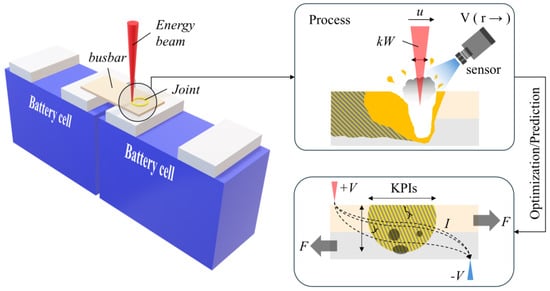Welding Challenges and Quality Assurance in Electric Vehicle Battery Pack Manufacturing
Abstract
:1. Introduction
1.1. Significance
1.2. EV Battery Architecture
1.3. Joining Applications

1.4. The Purpose of This Study
2. Key Performance Indicators and Challenges
2.1. Electrical Performance
2.2. Welding Temperature
2.3. Mechanical Performance
2.4. Material and Metalurgical Aspects
3. Quality Assurance Approaches for Battery Welding Applications
3.1. State of Practice
3.2. Monitoring and Quality Assessment
3.2.1. Laser Welding
3.2.2. Ultrasonic Welding
3.2.3. Resistance Spot Welding
3.3. Process Optimisation
3.3.1. Laser Welding
3.3.2. Ultrasonic Welding
3.3.3. Resistance Spot Welding
4. Conclusions and Outlook
4.1. Conclusions
4.2. Future Directions
Author Contributions
Funding
Data Availability Statement
Acknowledgments
Conflicts of Interest
References
- Athanasopoulou, L.; Bikas, H.; Papacharalampopoulos, A.; Stavropoulos, P.; Chryssolouris, G. An industry 4.0 approach to electric vehicles. Int. J. Comput. Integr. Manuf. 2023, 36, 334–348. [Google Scholar] [CrossRef]
- Trends in Batteries, Global EV Outlook 2023 by IEA. Available online: https://www.iea.org/reports/global-ev-outlook-2023/trends-in-batteries (accessed on 15 January 2024).
- Battery European Partnership Association. Available online: https://bepassociation.eu (accessed on 15 January 2024).
- Duffner, F.; Wentker, M.; Greenwood, M.; Leker, J. Battery cost modeling: A review and directions for future research. Renew. Sustain. Energy Rev. 2020, 127, 109872. [Google Scholar] [CrossRef]
- König, A.; Nicoletti, L.; Schröder, D.; Wolff, S.; Waclaw, A.; Lienkamp, M. An overview of parameter and cost for battery electric vehicles. World Electr. Veh. J. 2021, 12, 21. [Google Scholar] [CrossRef]
- Yuan, C.; Deng, Y.; Li, T.; Yang, F. Manufacturing energy analysis of lithium ion battery pack for electric vehicles. CIRP Ann. 2017, 66, 53–56. [Google Scholar] [CrossRef]
- Han, X.; Lu, L.; Zheng, Y.; Feng, X.; Li, Z.; Li, J.; Ouyang, M. A review on the key issues of the lithium ion battery degradation among the whole life cycle. ETransportation 2019, 1, 100005. [Google Scholar] [CrossRef]
- Kawamoto, R.; Mochizuki, H.; Moriguchi, Y.; Nakano, T.; Motohashi, M.; Sakai, Y.; Inaba, A. Estimation of CO2 emissions of internal combustion engine vehicle and battery electric vehicle using LCA. Sustainability 2019, 11, 2690. [Google Scholar] [CrossRef]
- Athanasopoulou, L.; Bikas, H.; Stavropoulos, P. Comparative well-to-wheel emissions assessment of internal combustion engine and battery electric vehicles. Procedia CIRP 2018, 78, 25–30. [Google Scholar] [CrossRef]
- EV Battery Production, Building the Battery Pack. Available online: https://www.automotivemanufacturingsolutions.com/ev-battery-production/building-the-battery-pack/41711.article (accessed on 15 January 2024).
- Zwicker, M.F.R.; Moghadam, M.; Zhang, W.; Nielsen, C.V. Automotive battery pack manufacturing–a review of battery to tab joining. J. Adv. Join. Process. 2020, 1, 100017. [Google Scholar] [CrossRef]
- Grabmann, S.; Kriegler, J.; Harst, F.; Günter, F.J.; Zaeh, M.F. Laser welding of current collector foil stacks in battery production–mechanical properties of joints welded with a green high-power disk laser. Int. J. Adv. Manuf. Technol. 2022, 118, 2571–2586. [Google Scholar] [CrossRef]
- Das, A.; Li, D.; Williams, D.; Greenwood, D. Joining technologies for automotive battery systems manufacturing. World Electr. Veh. J. 2018, 9, 22. [Google Scholar] [CrossRef]
- Elangovan, S.; Semeer, S.; Prakasan, K. Temperature and stress distribution in ultrasonic metal welding—An FEA-based study. J. Mater. Process. Technol. 2009, 209, 1143–1150. [Google Scholar] [CrossRef]
- Das, A.; Masters, I.; Williams, D. Process robustness and strength analysis of multi-layered dissimilar joints using ultrasonic metal welding. Int. J. Adv. Manuf. Technol. 2019, 101, 881–900. [Google Scholar] [CrossRef]
- Long, Y.; Twiefel, J.; Wallaschek, J. A review on the mechanisms of ultrasonic wedge-wedge bonding. J. Mater. Process. Technol. 2017, 245, 241–258. [Google Scholar] [CrossRef]
- Zhang, C.; Li, H.; Liu, Q.; Huang, C.; Zhou, K. Ultrasonic Welding of Aluminum to Steel: A Review. Metals 2022, 13, 29. [Google Scholar] [CrossRef]
- Kang, H.; Sharma, A.; Jung, J.P. Recent progress in transient liquid phase and wire bonding technologies for power electronics. Metals 2020, 10, 934. [Google Scholar] [CrossRef]
- Stavropoulos, P.; Sabatakakis, K.; Papacharalampopoulos, A.; Mourtzis, D. Infrared (IR) quality assessment of robotized resistance spot welding based on machine learning. Int. J. Adv. Manuf. Technol. 2022, 119, 1785–1806. [Google Scholar] [CrossRef]
- Brand, M.J.; Schmidt, P.A.; Zaeh, M.F.; Jossen, A. Welding techniques for battery cells and resulting electrical contact resistances. J. Energy Storage 2015, 1, 7–14. [Google Scholar] [CrossRef]
- Papacharalampopoulos, A.; Stavropoulos, P.; Stavridis, J. Adaptive control of thermal processes: Laser welding and additive manufacturing paradigms. Procedia CIRP 2018, 67, 233–237. [Google Scholar] [CrossRef]
- Sadeghian, A.; Iqbal, N. A review on dissimilar laser welding of steel-copper, steel-aluminum, aluminum-copper, and steel-nickel for electric vehicle battery manufacturing. Opt. Laser Technol. 2022, 146, 107595. [Google Scholar] [CrossRef]
- Ascari, A.; Fortunato, A. Laser dissimilar welding of highly reflective materials for E-Mobility applications. Join. Process. Dissimilar Adv. Mater. 2022, 579–645. [Google Scholar] [CrossRef]
- Dimatteo, V.; Ascari, A.; Fortunato, A. Continuous laser welding with spatial beam oscillation of dissimilar thin sheet materials (Al–Cu and Cu–Al): Process optimization and characterization. J. Manuf. Process. 2019, 44, 158–165. [Google Scholar] [CrossRef]
- Prieto, C.; Vaamonde, E.; Diego-Vallejo, D.; Jimenez, J.; Urbach, B.; Vidne, Y.; Shekel, E. Dynamic laser beam shaping for laser aluminium welding in e-mobility applications. Procedia CIRP 2020, 94, 596–600. [Google Scholar] [CrossRef]
- Das, A.; Ashwin, T.R.; Barai, A. Modelling and characterisation of ultrasonic joints for Li-ion batteries to evaluate the impact on electrical resistance and temperature raise. J. Energy Storage 2019, 22, 239–248. [Google Scholar] [CrossRef]
- Hoekstra, F.S.; Bergveld, H.J.; Donkers, M.C.F. Optimal Control of Active Cell Balancing: Extending the Range and Useful Lifetime of a Battery Pack. IEEE Trans. Control Syst. Technol. 2022, 30, 2759–2766. [Google Scholar] [CrossRef]
- Solchenbach, T.; Plapper, P.; Cai, W. Electrical performance of laser braze-welded aluminum–copper interconnects. J. Manuf. Process. 2014, 16, 183–189. [Google Scholar] [CrossRef]
- Huang, W.; Wang, H.; Rinker, T.; Tan, W. Investigation of metal mixing in laser keyhole welding of dissimilar metals. Mater. Des. 2020, 195, 109056. [Google Scholar] [CrossRef]
- Mathivanan, K.; Plapper, P. Laser welding of dissimilar copper and aluminum sheets by shaping the laser pulses. Procedia Manuf. 2019, 36, 154–162. [Google Scholar] [CrossRef]
- Indhu, R.; Vivek, V.; Sarathkumar, L.; Bharatish, A.; Soundarapandian, S. Overview of laser absorptivity measurement techniques for material processing. Lasers Manuf. Mater. Process. 2018, 5, 458–481. [Google Scholar] [CrossRef]
- Bohn, P.; Liebig, G.; Komsiyska, L.; Wittstock, G. Temperature propagation in prismatic lithium-ion-cells after short term thermal stress. J. Power Sources 2016, 313, 30–36. [Google Scholar] [CrossRef]
- Das, A.; Li, D.; Williams, D.; Greenwood, D. Weldability and shear strength feasibility study for automotive electric vehicle battery tab interconnects. J. Braz. Soc. Mech. Sci. Eng. 2019, 41, 54. [Google Scholar] [CrossRef]
- Kah, P.; Vimalraj, C.; Martikainen, J.; Suoranta, R. Factors influencing Al–Cu weld properties by intermetallic compound formation. Int. J. Mech. Mater. Eng. 2015, 10, 1–13. [Google Scholar] [CrossRef]
- Lassnig, A.; Pelzer, R.; Gammer, C.; Khatibi, G. Role of intermetallics on the mechanical fatigue behavior of Cu–Al ball bond interfaces. J. Alloys Compd. 2015, 646, 803–809. [Google Scholar] [CrossRef]
- Lee, S.J.; Nakamura, H.; Kawahito, Y.; Katayama, S. Effect of welding speed on microstructural and mechanical properties of laser lap weld joints in dissimilar Al and Cu sheets. Sci. Technol. Weld. Join. 2014, 19, 111–118. [Google Scholar] [CrossRef]
- Zare, M.; Pouranvari, M. Metallurgical joining of aluminium and copper using resistance spot welding: Microstructure and mechanical properties. Sci. Technol. Weld. Join. 2021, 26, 461–469. [Google Scholar] [CrossRef]
- Liu, J.; Cao, B.; Yang, J. Texture and intermetallic compounds of the Cu/Al dissimilar joints by high power ultrasonic welding. J. Manuf. Process. 2020, 76, 34–45. [Google Scholar] [CrossRef]
- Chen, S.; Zhai, Z.; Huang, J.; Zhao, X.; Xiong, J. Interface microstructure and fracture behavior of single/dual-beam laser welded steel-Al dissimilar joint produced with copper interlayer. Int. J. Adv. Manuf. Technol. 2016, 82, 631–643. [Google Scholar] [CrossRef]
- Shin, H.S.; de Leon, M. Mechanical performance and electrical resistance of ultrasonic welded multiple Cu-Al layers. J. Mater. Process. Technol. 2017, 241, 141–153. [Google Scholar] [CrossRef]
- Ali, S.; Shin, J. In-Depth Characterization of Laser-Welded Aluminum-and-Copper Dissimilar Joint for Electric Vehicle Battery Connections. Materials 2022, 15, 7463. [Google Scholar] [CrossRef] [PubMed]
- Measuring Welding Resistance to Improve the Performance of Lithium-Ion Batteries, HIOKI. Available online: https://www.hioki.com/euro-en/industries-solutions/manufacturing/rm3545.html (accessed on 15 January 2024).
- Measuring Busbar Weld Resistance in Battery Packs, Tektronix. Available online: https://www.tek.com/en/documents/application-note/measuring-busbar-weld-resistance-in-battery-packs (accessed on 15 January 2024).
- Battery Weld Inspection Solutions, moviTHERM. Available online: https://movitherm.com/solutions/quality-inspection/battery-weld-inspection-for-quality-assurance/ (accessed on 15 January 2024).
- Busbar Welding Module, Raylase. Available online: https://www.raylase.de/en/products/prefocusing-deflection-units/busbar-welding-module.html (accessed on 15 January 2024).
- Hesse in CHARGED: Electric Vehicles Magazine: “A Closer Look at Wire Bonding”, Hesse Mechatronics. Available online: https://www.hesse-mechatronics.com/en/hesse-im-charged-electric-vehicles-magazine-a-closer-look-at-wire-bonding/ (accessed on 20 March 2024).
- Stavropoulos, P.; Sabatakakis, K.; Bikas, H.; Papacharalampopoulos, A. Monitoring and Quality Assurance of Laser Welding: From Offline Sample-Based Testing to In-Process Real-Time AI Inference and Digital Twins. In A Guide to Laser Welding, 1st ed.; Pereira, A.B., Marques, E.S.V., da Silva, F.J.G., Eds.; NOVA Science Publishers: Hauppauge, NY, USA, 2024; Volume 1, pp. 329–357. [Google Scholar]
- Bondtec Accelerated Mechanical Fatigue Interconnect Testing, F&S Bondtec Austria. Available online: https://www.fsbondtec.at/anwendungen/bamfit-a-rapid-test-for-reliability-of-heavy-wire-bonds/?lang=en (accessed on 20 March 2024).
- Stavropoulos, P.; Bikas, H.; Sabatakakis, K.; Theoharatos, C.; Grossi, S. Quality assurance of battery laser welding: A data-driven approach. Procedia CIRP 2022, 111, 784–789. [Google Scholar] [CrossRef]
- Chianese, G.; Franciosa, P.; Nolte, J.; Ceglarek, D.; Patalano, S. Characterization of photodiodes for detection of variations in part-to-part gap and weld penetration depth during remote laser welding of copper-to-steel battery tab connectors. J. Manuf. Sci. Eng. 2022, 144, 071004. [Google Scholar] [CrossRef]
- Kang, S.; Lee, K.; Kang, M.; Jang, Y.H.; Kim, C. Weld-penetration-depth estimation using deep learning models and multisensor signals in Al/Cu laser overlap welding. Opt. Laser Technol. 2023, 161, 109179. [Google Scholar] [CrossRef]
- Sokolov, M.; Franciosa, P.; Sun, T.; Ceglarek, D.; Dimatteo, V.; Ascari, A.; Nagel, F. Applying optical coherence tomography for weld depth monitoring in remote laser welding of automotive battery tab connectors. J. Laser Appl. 2021, 33, 012028. [Google Scholar] [CrossRef]
- Lee, K.; Kang, S.; Kang, M.; Yi, S.; Kim, C. Estimation of Al/Cu laser weld penetration in photodiode signals using deep neural network classification. J. Laser Appl. 2021, 33, 042009. [Google Scholar] [CrossRef]
- Caprio, L.; Previtali, B.; Demir, A.G. Sensor Selection and Defect Classification via Machine Learning During the Laser Welding of Busbar Connections for High-Performance Battery Pack Production. Lasers Manuf. Mater. Process. 2024, 1–24. [Google Scholar] [CrossRef]
- Rohkohl, E.; Kraken, M.; Schönemann, M.; Breuer, A.; Herrmann, C. How to characterize a NDT method for weld inspection in battery cell manufacturing using deep learning. Int. J. Adv. Manuf. Technol. 2022, 119, 4829–4843. [Google Scholar] [CrossRef]
- Will, T.; Müller, J.; Müller, R.; Hölbling, C.; Goth, C.; Schmidt, M. Prediction of electrical resistance of laser-welded copper pin-pairs with surface topographical information from inline post-process observation by optical coherence tomography. Int. J. Adv. Manuf. Technol. 2023, 125, 1955–1963. [Google Scholar] [CrossRef]
- Mayr, A.; Lutz, B.; Weigelt, M.; Gläßel, T.; Kißkalt, D.; Masuch, M.; Franke, J. Evaluation of machine learning for quality monitoring of laser welding using the example of the contacting of hairpin windings. In Proceedings of the 2018 8th International Electric Drives Production Conference (EDPC), Schweinfurt, Germany, 4–5 December 2018; pp. 1–7. [Google Scholar]
- Simonds, B.J.; Tran, B.; Williams, P.A. In situ monitoring of Cu/Al laser welding using laser induced fluorescence. Procedia CIRP 2020, 94, 605–609. [Google Scholar] [CrossRef]
- Li, H.; Choi, H.; Ma, C.; Zhao, J.; Jiang, H.; Cai, W.; Li, X. Transient temperature and heat flux measurement in ultrasonic joining of battery tabs using thin-film microsensors. J. Manuf. Sci. Eng. 2013, 135, 051015. [Google Scholar] [CrossRef]
- Balz, I.; Abi Raad, E.; Rosenthal, E.; Lohoff, R.; Schiebahn, A.; Reisgen, U.; Vorländer, M. Process monitoring of ultrasonic metal welding of battery tabs using external sensor data. J. Adv. Join. Process. 2020, 1, 100005. [Google Scholar] [CrossRef]
- Guo, W.; Shao, C.; Kim, T.H.; Hu, S.J.; Jin, J.J.; Spicer, J.P.; Wang, H. Online process monitoring with near-zero misdetection for ultrasonic welding of lithium-ion batteries: An integration of univariate and multivariate methods. J. Manuf. Syst. 2016, 38, 141–150. [Google Scholar] [CrossRef]
- Meng, Y.; Shao, C. Physics-informed ensemble learning for online joint strength prediction in ultrasonic metal welding. Mech. Syst. Signal Process. 2022, 181, 109473. [Google Scholar] [CrossRef]
- Müller, F.W.; Schiebahn, A.; Reisgen, U. Quality prediction of disturbed ultrasonic metal welds. J. Adv. Join. Process. 2022, 5, 100086. [Google Scholar] [CrossRef]
- Han, L.; Gao, R.; Zhong, J.; Li, H. Wire bonding dynamics monitoring by wavelet analysis. Sens. Actuators A Phys. 2007, 137, 41–50. [Google Scholar] [CrossRef]
- Feng, W.; Chen, X.; Wang, C.; Shi, Y. Application research on the time–frequency analysis method in the quality detection of ultrasonic wire bonding. Int. J. Distrib. Sens. Netw. 2021, 17, 15501477211018346. [Google Scholar] [CrossRef]
- Lin, H.J.; Chang, H.S. In-process monitoring of micro series spot welding using dual accelerometer system. Weld. World 2019, 63, 1641–1654. [Google Scholar] [CrossRef]
- He, Y.; Yang, K.; Wang, X.; Huang, H.; Chen, J. Quality Prediction and Parameter Optimisation of Resistance Spot Welding Using Machine Learning. Appl. Sci. 2022, 12, 9625. [Google Scholar] [CrossRef]
- Dimatteo, V.; Ascari, A.; Liverani, E.; Fortunato, A. Experimental investigation on the effect of spot diameter on continuous-wave laser welding of copper and aluminum thin sheets for battery manufacturing. Opt. Laser Technol. 2022, 145, 107495. [Google Scholar] [CrossRef]
- Francioso, M.; Angeloni, C.; Fortunato, A.; Liverani, E.; Ascari, A. Experimental investigation on the effect of nickel-plating thickness on continuous-wave laser welding of copper and steel tab joints for battery manufacturing. Lasers Manuf. Mater. Process. 2024, 1–18. [Google Scholar] [CrossRef]
- Dhara, S.; Finuf, M.; Zediker, M.; Masters, I.; Barai, A.; Das, A. Utilising blue laser over infrared laser to enhance control of penetration depth and weld strength for producing electric vehicle battery interconnects. J. Mater. Process. Technol. 2023, 317, 117989. [Google Scholar] [CrossRef]
- Kamat, S.; Cai, W.; Rinker, T.J.; Bracey, J.; Xi, L.; Tan, W. A novel integrated process-performance model for laser welding of multi-layer battery foils and tabs. J. Mater. Process. Technol. 2023, 320, 118121. [Google Scholar] [CrossRef]
- Das, A.; Masters, I.; Haney, P. Modelling the impact of laser micro-joint shape and size on resistance and temperature for Electric Vehicle battery joining application. J. Energy Storage 2022, 52, 104868. [Google Scholar] [CrossRef]
- Hollatz, S.; Kremer, S.; Ünlübayir, C.; Sauer, D.U.; Olowinsky, A.; Gillner, A. Electrical modelling and investigation of laser beam welded joints for lithium-ion batteries. Batteries 2020, 6, 24. [Google Scholar] [CrossRef]
- Dhara, S.; Das, A. Impact of ultrasonic welding on multi-layered Al–Cu joint for electric vehicle battery applications: A layer-wise microstructural analysis. Mater. Sci. Eng. 2020, 791, 139795. [Google Scholar] [CrossRef]
- Meng, Y.; Rajagopal, M.; Kuntumalla, G.; Toro, R.; Zhao, H.; Chang, H.C.; Shao, C. Multi-objective optimization of peel and shear strengths in ultrasonic metal welding using machine learning-based response surface methodology. Math. Biosci. Eng. 2020, 17. [Google Scholar] [CrossRef]
- Singh, A.R.; Sudarsan, C.; Das, A.; Hazra, S.; Panda, S.K. Process optimization and characterization of ultra-thin dissimilar sheet material joints for battery applications using ultrasonic welding. J. Mater. Eng. Perform. 2022, 31, 4133–4149. [Google Scholar] [CrossRef]
- de Leon, M.; Shin, H.S. Prediction of optimum welding parameters for weld-quality characterization in dissimilar ultrasonic-welded Al-to-Cu tabs for Li-ion batteries. Met. Mater. Int. 2023, 29, 1079–1094. [Google Scholar] [CrossRef]
- Jeong, J.M.; Kim, D.; Kim, J.; Bang, J.; Jung, S.B.; Kim, M.S. Improving mechanical stability of Al/Cu ultrasonic bonded joint for battery tab by adopting electroplated Ni interlayer. J. Mater. Sci. Mater. Electron. 2024, 35, 308. [Google Scholar] [CrossRef]
- Shen, N.; Samanta, A.; Ding, H.; Cai, W.W. Simulating microstructure evolution of ultrasonic welding of battery tabs. Procedia Manuf. 2016, 5, 399–416. [Google Scholar] [CrossRef]
- Kang, B.; Cai, W.; Tan, C.A. Dynamic stress analysis of battery tabs under ultrasonic welding. J. Manuf. Sci. Eng. 2014, 136, 041011. [Google Scholar] [CrossRef]
- Zhao, N.; Li, W.; Cai, W.W.; Abell, J.A. A fatigue life study of ultrasonically welded lithium-ion battery tab joints based on electrical resistance. J. Manuf. Sci. Eng. 2014, 136, 051003. [Google Scholar] [CrossRef]
- Bieliszczuk, K.; Zręda, J.; Chmielewski, T. Selected properties of aluminum ultrasonic wire bonded joints with nickel-plated steel substrate for 18650 cylindrical cells. J. Adv. Join. Process. 2024, 9, 100197. [Google Scholar] [CrossRef]
- Kumar, N.; Ramakrishnan, S.M.; Panchapakesan, K.; Subramaniam, D.; Masters, I.; Dowson, M.; Das, A. In-depth evaluation of micro-resistance spot welding for connecting tab to 18,650 Li-ion cells for electric vehicle battery application. Int. J. Adv. Manuf. Technol. 2022, 121, 6581–6597. [Google Scholar] [CrossRef]
- Masomtob, M.; Sukondhasingha, R.; Becker, J.; Sauer, D.U. Parametric study of spot welding between Li-ion battery cells and sheet metal connectors. Eng. J. 2017, 21, 457–473. [Google Scholar] [CrossRef]
- Phichai, N.; Kaewtatip, P.; Lailuck, V.; Rompho, S.; Masomtob, M. Parametric effects of resistance spot welding between Li-ion cylindrical battery cell and nickel conductor strip. In IOP Conference Series: Materials Science and Engineering; IOP Publishing: Bristol, UK, 2019; Volume 501, p. 012027. [Google Scholar]
- Stavropoulos, P.; Sabatakakis, K. Quality Assurance in Resistance Spot Welding: State of Practice, State of the Art, and Prospects. Metals 2024, 14, 185. [Google Scholar] [CrossRef]
- Amiri, N.; Farrahi, G.H.; Kashyzadeh, K.R.; Chizari, M. Applications of ultrasonic testing and machine learning methods to predict the static & fatigue behavior of spot-welded joints. J. Manuf. Process. 2020, 52, 26–34. [Google Scholar]
- Mypati, O.; Pal, S.K.; Srirangam, P. Tensile and fatigue properties of aluminum and copper micro joints for Li-ion battery pack applications. Forces Mech. 2022, 7, 100101. [Google Scholar] [CrossRef]
- Wu, S.; Kaden, N.; Dröder, K. A Systematic Review on Lithium-Ion Battery Disassembly Processes for Efficient Recycling. Batteries 2023, 9, 297. [Google Scholar] [CrossRef]
- Schimanek, R.; Bilge, P.; Dietrich, F. Automated remanufacturing of lithium-ion batteries with shear separation, ultrasonic separation, and ultrasonic welding. Procedia CIRP 2023, 116, 227–232. [Google Scholar] [CrossRef]
- Panagiotopoulou, V.C.; Paraskevopoulou, A.; Stavropoulos, P. A Modelling-Based Framework for Carbon Emissions Calculation in Additive Manufacturing: A Stereolithography Case Study. Processes 2023, 11, 2574. [Google Scholar] [CrossRef]
- Stavropoulos, P.; Papacharalampopoulos, A.; Michail, C.K.; Chryssolouris, G. Robust additive manufacturing performance through a control oriented digital twin. Metals 2021, 11, 708. [Google Scholar] [CrossRef]
- Wang, Q.; Jiao, W.; Zhang, Y. Deep learning-empowered digital twin for visualized weld joint growth monitoring and penetration control. J. Manuf. Syst. 2020, 57, 429–439. [Google Scholar] [CrossRef]
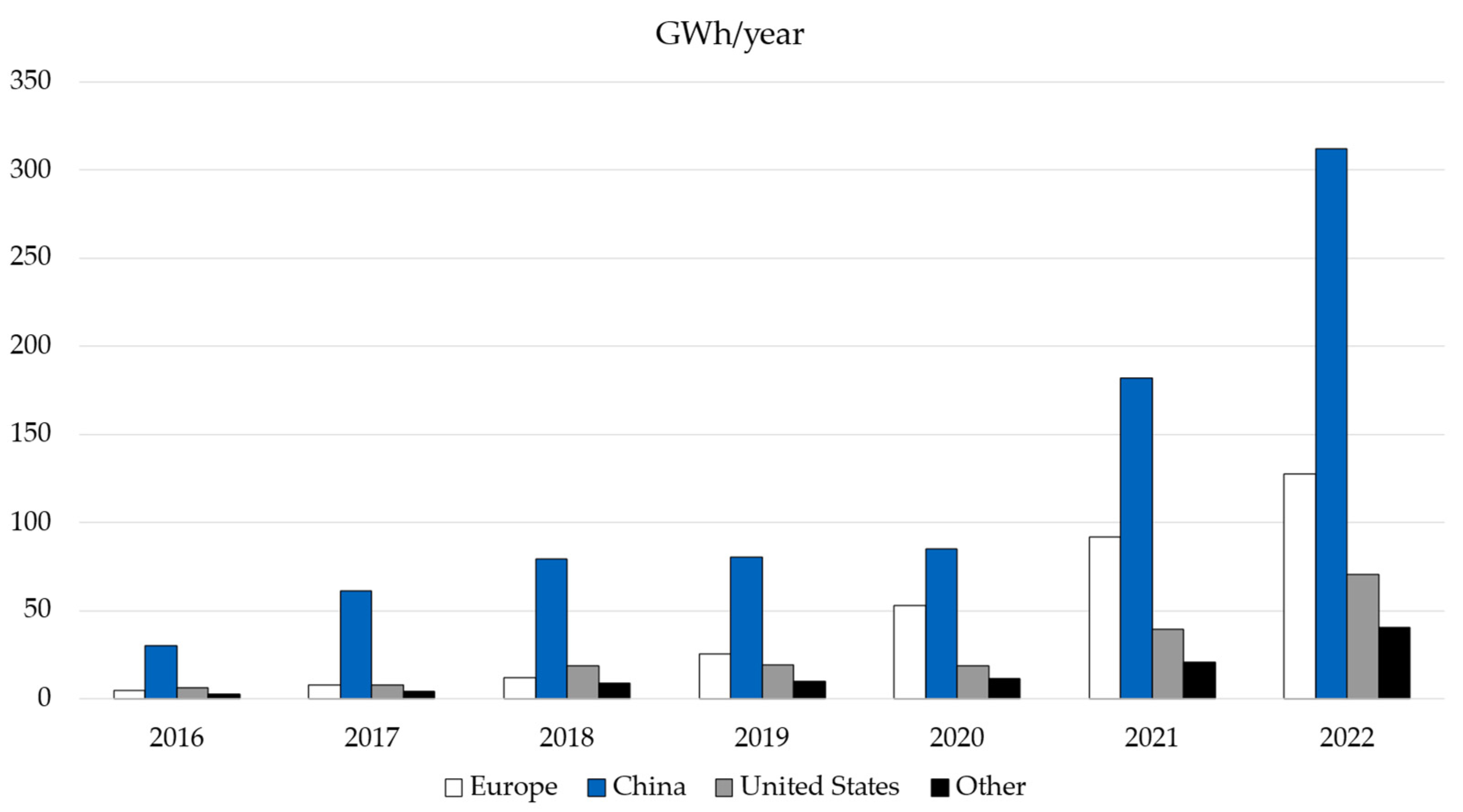

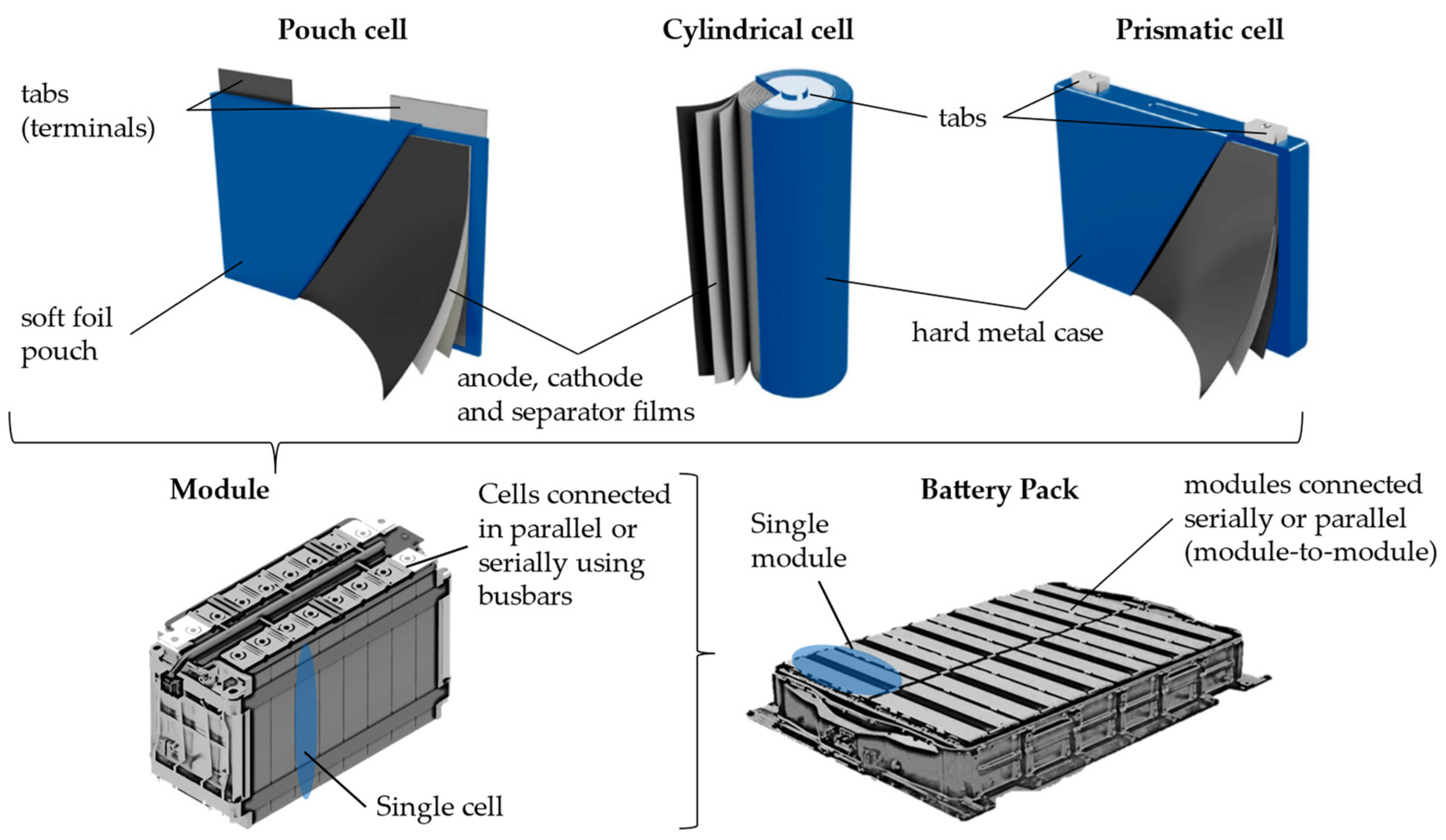
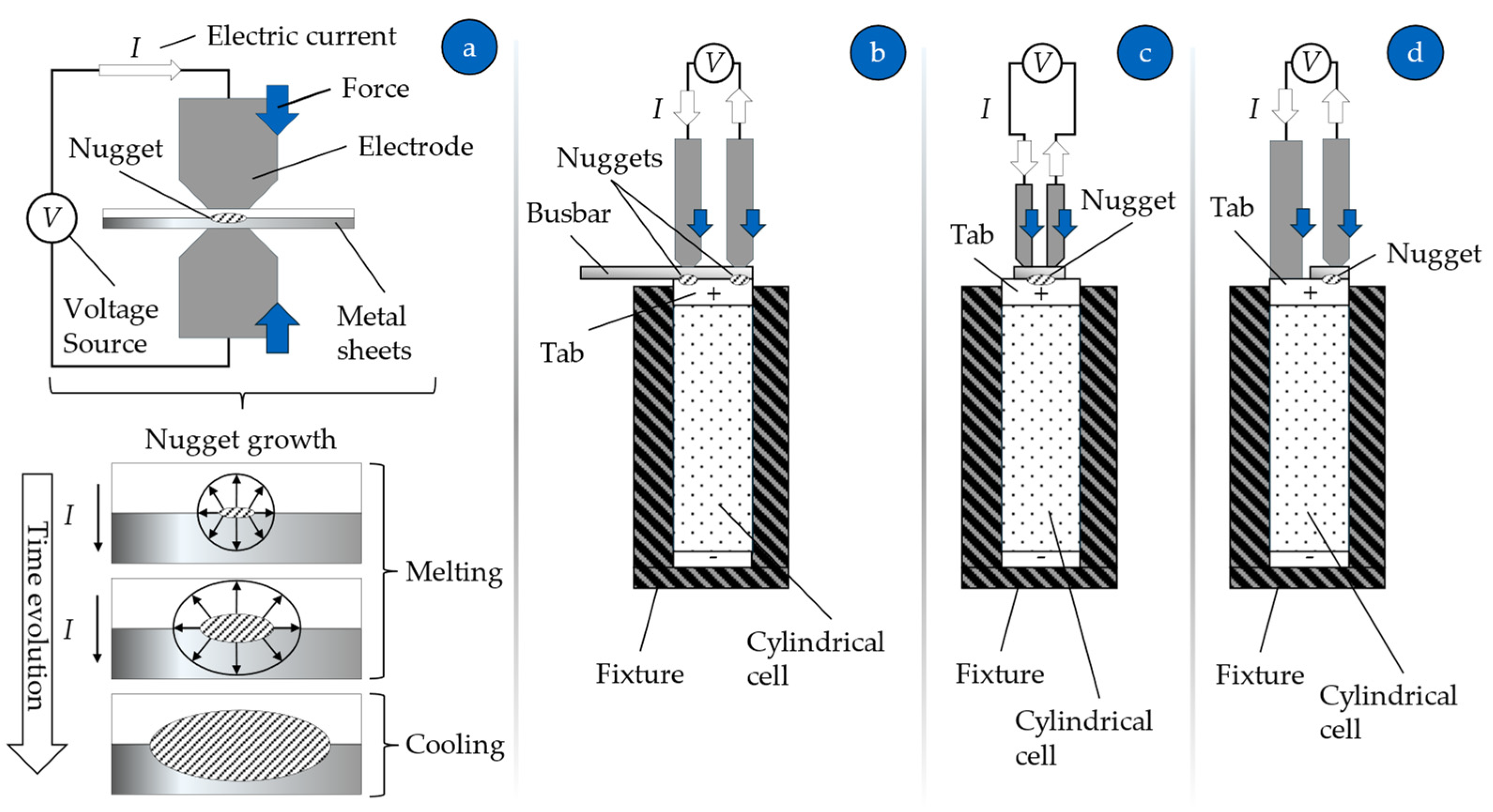

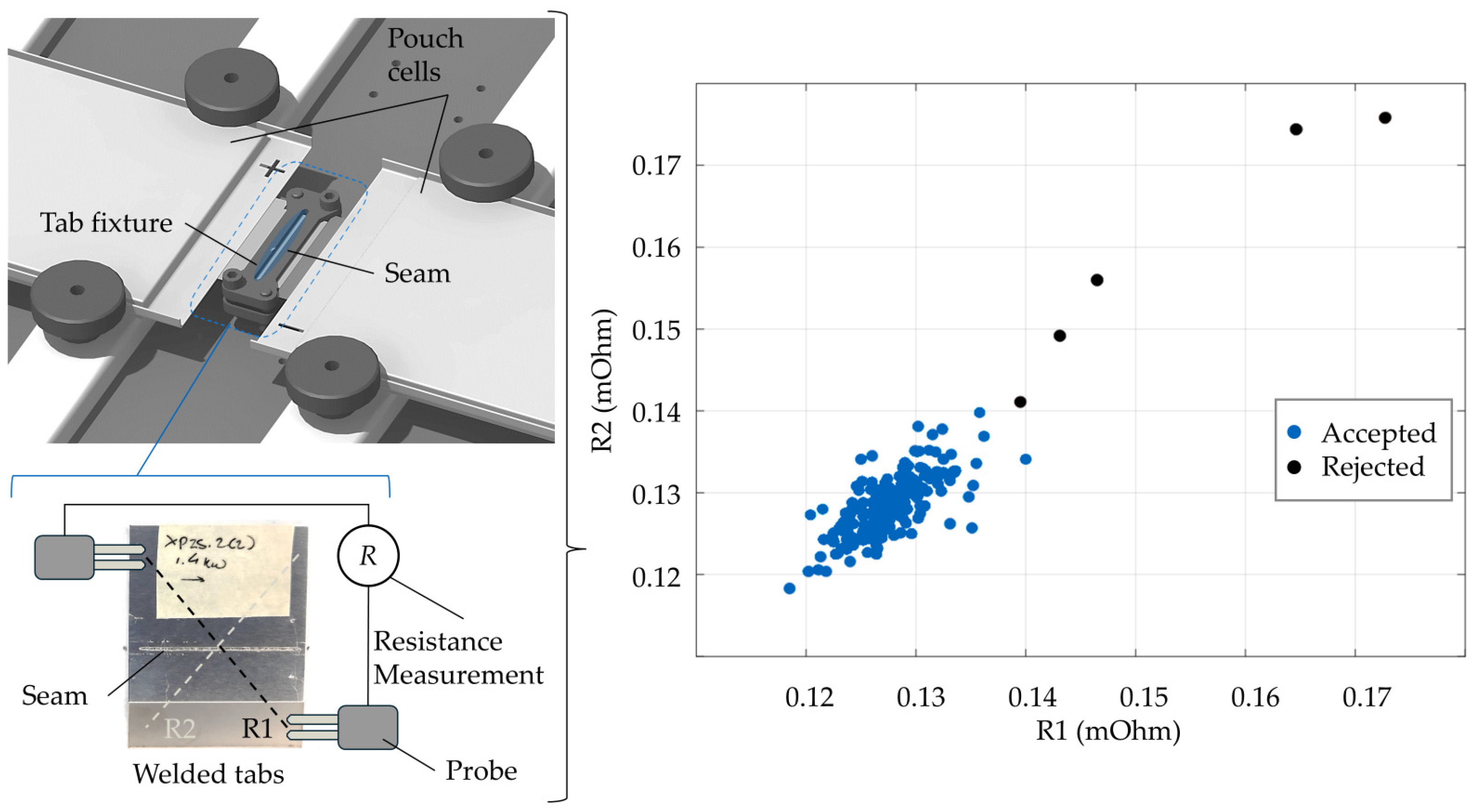
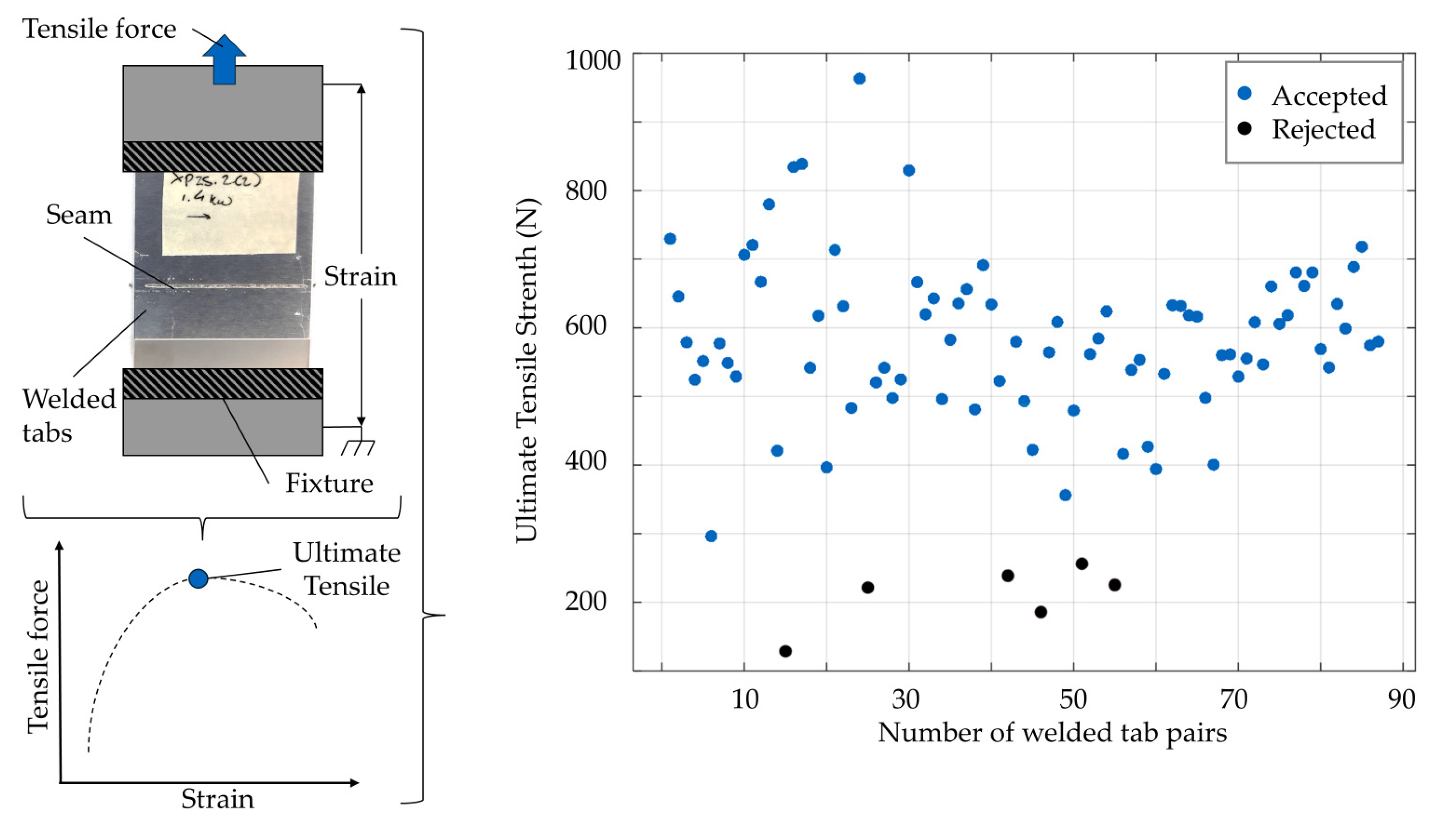

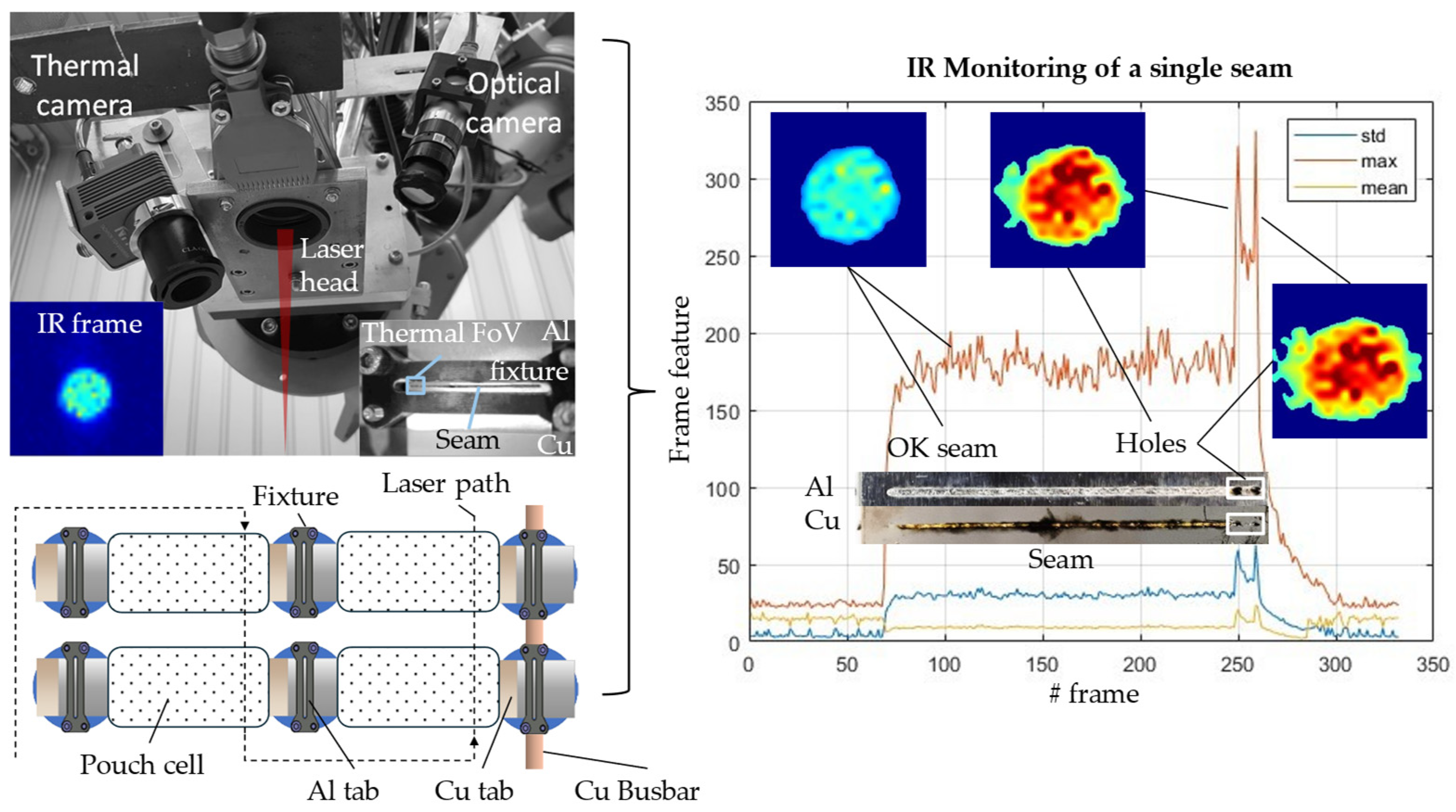
Disclaimer/Publisher’s Note: The statements, opinions and data contained in all publications are solely those of the individual author(s) and contributor(s) and not of MDPI and/or the editor(s). MDPI and/or the editor(s) disclaim responsibility for any injury to people or property resulting from any ideas, methods, instructions or products referred to in the content. |
© 2024 by the authors. Licensee MDPI, Basel, Switzerland. This article is an open access article distributed under the terms and conditions of the Creative Commons Attribution (CC BY) license (https://creativecommons.org/licenses/by/4.0/).
Share and Cite
Stavropoulos, P.; Sabatakakis, K.; Bikas, H. Welding Challenges and Quality Assurance in Electric Vehicle Battery Pack Manufacturing. Batteries 2024, 10, 146. https://doi.org/10.3390/batteries10050146
Stavropoulos P, Sabatakakis K, Bikas H. Welding Challenges and Quality Assurance in Electric Vehicle Battery Pack Manufacturing. Batteries. 2024; 10(5):146. https://doi.org/10.3390/batteries10050146
Chicago/Turabian StyleStavropoulos, Panagiotis, Kyriakos Sabatakakis, and Harry Bikas. 2024. "Welding Challenges and Quality Assurance in Electric Vehicle Battery Pack Manufacturing" Batteries 10, no. 5: 146. https://doi.org/10.3390/batteries10050146
APA StyleStavropoulos, P., Sabatakakis, K., & Bikas, H. (2024). Welding Challenges and Quality Assurance in Electric Vehicle Battery Pack Manufacturing. Batteries, 10(5), 146. https://doi.org/10.3390/batteries10050146






_Bikas.png)
